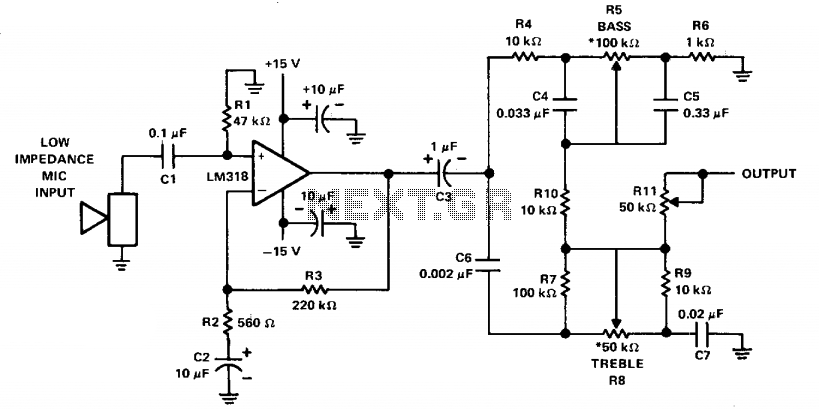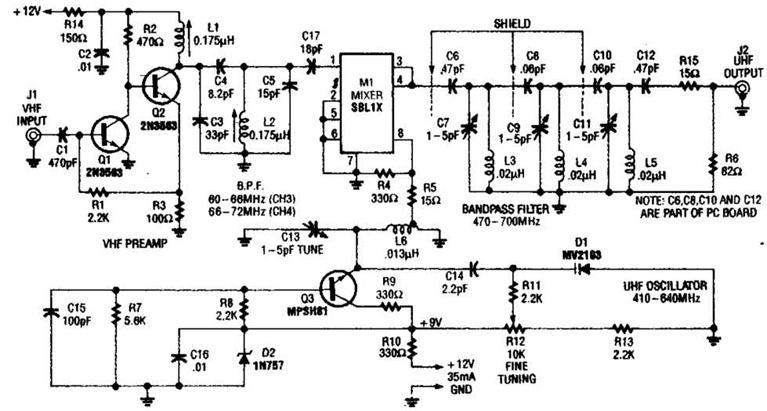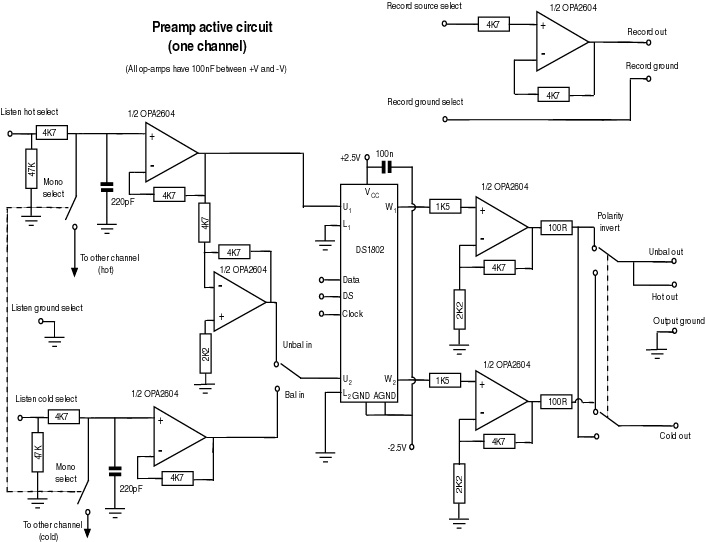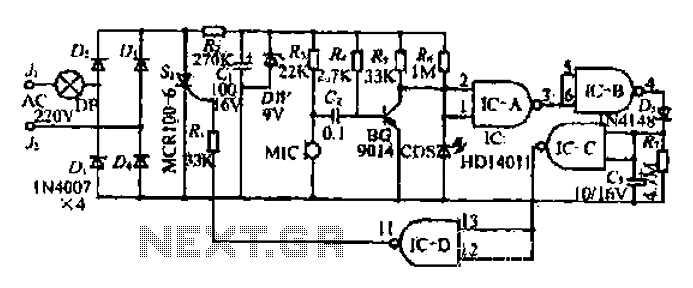
Mike preamp with tone control

The LM318 operational amplifier is configured as a standard non-inverting amplifier. Resistor R1 (47 kΩ) provides a ground path for the bias current of the non-inverting input. The combination of R2 (560Ω) and C2 (10µF) creates a frequency roll-off below 30 Hz. Above 30 Hz, the gain remains relatively constant at approximately 50 dB, determined by the ratio of R3 to R2. Resistor R3 (200 kΩ) supplies negative feedback from the output to the inverting input of the operational amplifier. Capacitor C3 (1.0 µF electrolytic) AC couples the preamplifier to the tone control section. The upper portion of the tone control section regulates the bass response, while the lower portion adjusts the treble frequency response. The tone controls (R5 and R8) utilize audio taper (logarithmic) potentiometers. A 50 kΩ potentiometer at the output can be employed to adjust the output level or gain of the preamplifier.
The circuit utilizes the LM318 operational amplifier, which is known for its high-speed performance and wide bandwidth, making it suitable for audio applications. In this configuration, the non-inverting amplifier setup allows for a stable gain with low distortion, which is essential for high-fidelity audio processing. The biasing of the non-inverting input through R1 ensures that the input stage operates correctly by providing a stable reference point for the input signal.
The frequency response of the amplifier is shaped by the components R2 and C2, which create a high-pass filter that effectively rolls off frequencies below 30 Hz. This is particularly useful in audio applications to eliminate unwanted low-frequency noise, ensuring that only the desired audio frequencies are amplified. The gain of the amplifier is set to approximately 50 dB, which is achieved by the feedback network formed by R3. The selection of R3 at 200 kΩ allows for sufficient negative feedback, which stabilizes the gain and improves linearity.
C3 serves as an AC coupling capacitor, preventing any DC offset from affecting the tone control section. This is crucial as tone controls typically operate on AC signals to adjust the tonal quality of the audio output. The tone control section consists of two main parts: the bass control at the top and the treble control at the bottom. Each section is designed using logarithmic potentiometers (R5 and R8), which provide a more natural adjustment of volume levels for human hearing.
The output stage of the preamplifier includes a 50 kΩ potentiometer that allows fine-tuning of the output level. This feature provides the user with the ability to match the output signal level to subsequent audio processing stages or to adjust for different audio sources. Overall, this circuit design is effective for enhancing audio signals while providing user-friendly controls for tonal adjustments.The LM318 op amp is operated as a standard non-inverting amplifier. Resistor Rl (47 k ohm) provides an input path to ground for the bias current of the non-inverting input. The combination of R2 (560 ohm) and C2 (10 /iF) provides a frequency roll-off below 30 Hz. At 30 Hz and above the gain is relatively flat at about 50 dB, set by the ratio R3/R2. R3 (200 k ohm) furnishes negative feedback from the output to the inverting input of thk op amp. C3 (1.0 µ electrolytic) ac couples the preamp to the tone control section. The top half of the tone control section is the bass control. The bottom half controls the treble frequency response. These tone controls (R5 and R8) require audio taper (logarithmic) potentiometers. The 50 k ohm potentiometer on the output can be used to set the output or gain of the preamp.
The circuit utilizes the LM318 operational amplifier, which is known for its high-speed performance and wide bandwidth, making it suitable for audio applications. In this configuration, the non-inverting amplifier setup allows for a stable gain with low distortion, which is essential for high-fidelity audio processing. The biasing of the non-inverting input through R1 ensures that the input stage operates correctly by providing a stable reference point for the input signal.
The frequency response of the amplifier is shaped by the components R2 and C2, which create a high-pass filter that effectively rolls off frequencies below 30 Hz. This is particularly useful in audio applications to eliminate unwanted low-frequency noise, ensuring that only the desired audio frequencies are amplified. The gain of the amplifier is set to approximately 50 dB, which is achieved by the feedback network formed by R3. The selection of R3 at 200 kΩ allows for sufficient negative feedback, which stabilizes the gain and improves linearity.
C3 serves as an AC coupling capacitor, preventing any DC offset from affecting the tone control section. This is crucial as tone controls typically operate on AC signals to adjust the tonal quality of the audio output. The tone control section consists of two main parts: the bass control at the top and the treble control at the bottom. Each section is designed using logarithmic potentiometers (R5 and R8), which provide a more natural adjustment of volume levels for human hearing.
The output stage of the preamplifier includes a 50 kΩ potentiometer that allows fine-tuning of the output level. This feature provides the user with the ability to match the output signal level to subsequent audio processing stages or to adjust for different audio sources. Overall, this circuit design is effective for enhancing audio signals while providing user-friendly controls for tonal adjustments.The LM318 op amp is operated as a standard non-inverting amplifier. Resistor Rl (47 k ohm) provides an input path to ground for the bias current of the non-inverting input. The combination of R2 (560 ohm) and C2 (10 /iF) provides a frequency roll-off below 30 Hz. At 30 Hz and above the gain is relatively flat at about 50 dB, set by the ratio R3/R2. R3 (200 k ohm) furnishes negative feedback from the output to the inverting input of thk op amp. C3 (1.0 µ electrolytic) ac couples the preamp to the tone control section. The top half of the tone control section is the bass control. The bottom half controls the treble frequency response. These tone controls (R5 and R8) require audio taper (logarithmic) potentiometers. The 50 k ohm potentiometer on the output can be used to set the output or gain of the preamp.





